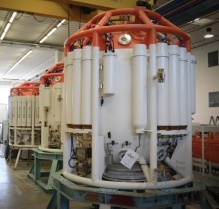
Verification of Diving Bell Weight ______________________________________________________ For this project, we were contacted by a manufacturer of diving equipment, who were interested in having custom design load pins manufactured that were suitable for use in a marine/offshore environment. Because they would be used in a lifting application that involved personnel, the traceability requirements were high, with 3.1 material certificates and charpy testing required. These load pins were required to measure the loads applied to the handling systems of the diving bells. The diving bells are lifted ready for deployment through a dedicated opening in the centre of the vessel called a moon pool, and are also recovered using the same lifting system. Next to the moon pool there are a series of vertical sheaves, which connect to the diving bell. The plan was to have load pins installed in these sheaves to determine the weight of the diving bell. This would ensure that there were no overload situations, which could potentially endanger the personnel inside.
Four load pins are installed per moon pool lifting system, each rated to 1000kN. Manufactured from stainless steel and with environmental sealing to IP67 for suitability in a marine environment, the load pins feature an internal amplifier to provide 4-20mA output. This allows the load measurement data to be exported direct to the vessels PLC system, where the results can be displayed and monitored for safety purposes.
The load pins were designed, manufactured and delivered within the required time frame, and the customer was very happy with their performance. They have since gone on to place orders for several more systems. |
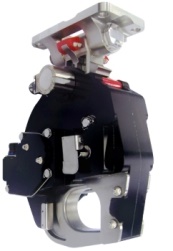
Helicopter Cargo Weight Indication ______________________________________________________ A manufacturer of specialist equipment for the aerospace industry contacted us
To enable the company to offer a weighing solution, the new hook incorporates a load measuring pin. LCM Systems initially designed a prototype pin for testing purposes, which had a load rating of 10,000 lbf. Due to the application, extensive independent testing by a UKAS approved test house was required for hardness testing, material testing and fluorescent penetration. Passivation process certification was also supplied.
Following successful evaluation, further orders were received for 20+ pins. The customer was extremely happy with both the load pin and the level of service received, stating |
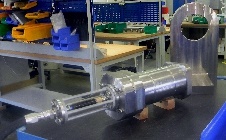
Single Point Mooring Buoy Mooring Line Tension Measurement ______________________________________________________ One of our regular customers, a supplier of safety systems for the oil and gas
Our customer was very happy with the load pin performance, and have subsequently placed orders for many more high capacity submersible load shackle pins. |
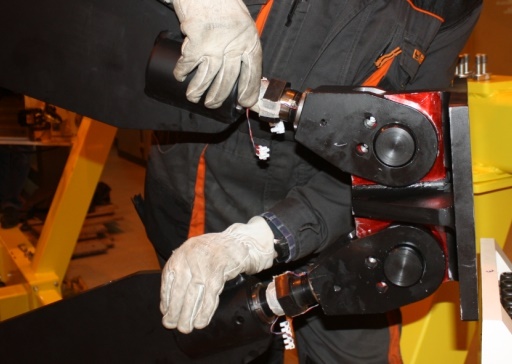
Tension Monitoring of Telescope Vanes ______________________________________________________ An international astronomical observatory is manufacturing a new instrument called WEAVE for the William Herschel Telescope (WHT) that incorporates wireless load pins developed by LCM Systems. There is a requirement for remote monitoring of the tensile forces in the telescope vanes. The wireless load pins are part of the assembly that determines preload force to ensure the positional alignment and accuracy of the approximately 4 tonne WEAVE optical corrector. This new multi-object survey spectrograph will allow astronomers to take optical spectra of up to 1000 stars and galaxies in a single exposure (currently only 150 objects can be observed simultaneously).
The telescope vanes are subject to a tensile force by tightening turnbuckles and operators need to know that force. Force measuring load pins provide invaluable information on the amount of preload the vanes are subject to and load monitoring ensures that the preload is applied equally to each of the eight vanes, as well as providing the combined force applied.
In addition to the 8 wireless load pins, a T24-HA handheld display was supplied to show the individual loads on each vane, as well as the total load. |
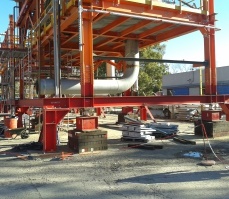
Centre of Gravity System For Heavy Lifts ______________________________________________________ An enquiry was received from a regular customer operating in the heavy lift industry. They were looking for a Centre of Gravity system (COG) that could be used in a variety of weighing applications.
A custom version of the popular CPA compression load cell was offered, rated to 250 tonnes and supplied complete with base plate and load cap for optimal accuracy. The requirement was for 10 load cells with individual handheld displays, but the customer wanted to be able to use any display with any of the load cells. To achieve this, the load cell design incorporated a TEDs chip, which holds information such as model, serial number and calibration settings. This allows the load cells and handheld displays to be interchangeable, saving time and increasing system functionality.
They can also be used for other measurement applications when not being used as part of the COG system.
A tablet display was also supplied as part of the system that showed the load on each load cell, the total load and the centre of gravity point.
For the first application, the COG system was used to weigh and transport 12 pipe rack modules with differing weights of up to 430 tonnes. The system proved to be instrumental in the successful lifting and transportation of the pipe rack modules.
Future use of the COG system will mainly be for determining the centre of gravity of ship to shore (container) cranes when they are taken out of service for maintenance purposes. |
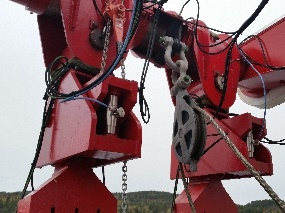
Crane Extension Gib Overload Monitoring ______________________________________________________ One of our regular customers had a requirement for two compression load cells that would be installed in the jib extension hooks of an A-frame floating crane. The crane has a lifting capacity of up to 400 tonnes at a height of 45m, but with the jib extended it can achieve a lifting height of up to 76m with a lifting capacity of 200 tonnes. The crane is operated by a Norwegian specialist crane rental company who hire it out for general marine lifting operations along the Norwegian coast as far as Bergen in the north down to Germany in the south.
The load cells were required to monitor the loads on the jib when it is extended to protect against overload situations that could result in it being overstressed and consequently susceptible to damage. The load cells are used to sense the force of the load during a lift, and when the load exceeds a pre-set percentage of the cranes rated capacity, an overload device temporarily stops the crane from lifting and only permits the lowering of the load.
Due to limited space, the load cells had height and width dimensional restrictions, so a custom design solution was required. With a height of 265mm and an 88mm maximum diameter, the load cells had a rated capacity of 35 tonnes. For suitability of use in a marine environment they also had environmental sealing to IP67, featured an integral amplifier to provide 4-20mA output for simple integration into the vessels PLC, and were supplied with 10m of armoured cable. Additionally, the load cells incorporated M42 x 2 load buttons on the top and bottom to assure more precise loading and hence more accurate and repeatable measurements. |
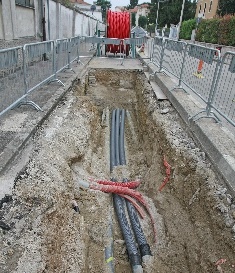
Cable Tension Monitoring ______________________________________________________ We were contacted by a customer with a requirement for a custom design load link for a cable laying application that would
The load link rating needed to be 50kN and the customer additionally requested the holes be sized to fit Green Pin G-4159 6.5te shackles. They also wanted the link to power it (obviously external power supply was not an option for this application). They also needed a removable cover to access the electronics for measurement data download and facilitate easy access to change the batteries when necessary.
Our design engineers were able to design a load link to the required dimensions which also featured environmental sealing to IP66 and had an accuracy 0.3% of rated load. |
